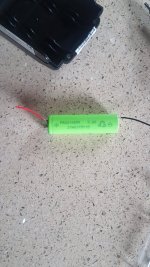You are using an out of date browser. It may not display this or other websites correctly.
You should upgrade or use an alternative browser.
You should upgrade or use an alternative browser.
18650 Batteries
- Thread starter Paul Marvin
- Start date
Chocolate fireguard
Active member
It sounded OK to me.Sorry I got that the wrong way round.
To incr
4 x 3.6v = 14.4v
To increase the voltage you arrange the cells in parallel so once you have the 2 sets of 4 cells in series you arrange those sets in Parallel to give you:
2 x 2000mah = 4000mah
I hope this helps
To increase the voltage, the cells are arranged in series so you will have:Sorry, I'm still bemused by:
'I found a brand new 4000mah 14.4v power tool battery on Ebay for around £14.00. This gave me 8 x 2000mah 18650 lithium cells'
Wouldn't 8 times 2000 mAh cells provide 16000 mAh?
4 x 3.6v = 14.4v
To increase the voltage you arrange the cells in parallel so once you have the 2 sets of 4 cells in series you arrange those sets in Parallel to give you:
2 x 2000mah = 4000mah
I hope this helps
Sorry I meant to say to increase the capacity not the voltage for parallelTo incr
To increase the voltage, the cells are arranged in series so you will have:
4 x 3.6v = 14.4v
To increase the voltage you arrange the cells in parallel so once you have the 2 sets of 4 cells in series you arrange those sets in Parallel to give you:
2 x 2000mah = 4000mah
I hope this helps
I fully appreciate the difference between batteries in series and in parallel – that if you line up 4 batteries end to end, each of which is rated at 3.6V, the overall PD between one end and the other is 4 x 3.6 = 14.4.V. If you then line up another 4 end to end and put them side by side with the first 4, the overall PD is still 14.4V, but you've doubled the capacity of the assemblage.
What I don't understand is how you can cobble together 8 batteries, each with a capacity of 2 Ah, and end up with only 4 Ah instead of 16 Ah – what's happened to the other12 Ah?
What I don't understand is how you can cobble together 8 batteries, each with a capacity of 2 Ah, and end up with only 4 Ah instead of 16 Ah – what's happened to the other12 Ah?
Chocolate fireguard
Active member
That's a very good question.I fully appreciate the difference between batteries in series and in parallel – that if you line up 4 batteries end to end, each of which is rated at 3.6V, the overall PD between one end and the other is 4 x 3.6 = 14.4.V. If you then line up another 4 end to end and put them side by side with the first 4, the overall PD is still 14.4V, but you've doubled the capacity of the assemblage.
What I don't understand is how you can cobble together 8 batteries, each with a capacity of 2 Ah, and end up with only 4 Ah instead of 16 Ah – what's happened to the other12 Ah?
If you just accept that each cell keeps its charge (7200 Coulombs of it) no matter how they are connected together - as most people do, I imagine - then it doesn't make sense.
I have never thought about it before.
I get all that, Ian . . . what I don't get is:
How can one 4 Ah battery assemblage be split up into 8, 2 Ah ones. Wouldn't one 4 Ah give 8 x 0.5 Ah – or one 16 Ah give 8 x 2 Ah?
I found a brand new 4000mah 14.4v power tool battery on Ebay for around £14.00. This gave me 8 x 2000mah 18650 lithium cells
How can one 4 Ah battery assemblage be split up into 8, 2 Ah ones. Wouldn't one 4 Ah give 8 x 0.5 Ah – or one 16 Ah give 8 x 2 Ah?
Tangent_tracker
Active member
When referring to a battery do you mean a single-cell battery? and vs what? Just want to clarify that's all. I prefer to refer to batteries as something that contains more than a single cell when talking technically, so that things are clear. Technically, single cells (whether AA or 18650's) can't be compared to cells because that is exactly what they are!A bit more, Lithium ion batteries cannot just burst into flames. However, just like any other battery they are a means of storing and electrical charge, and as such, if short circuited, can cause fire and injury. However, Li Ion cells are more inherently dangerous because they can suffer from an effect called "Thermal runaway", this can be triggered by an external short circuit or an internal one caused by over discharge and subsequent recharging. In the latter case they will ignite while under charge.
When I first started lamp building, now many years ago, I was disturbed to find deliveries of Li Ion cells from the Far East were by just dropping the loose cells into a jiffy bag and putting them into the post. Obviously if cells settled in a particular way they could cause a short. It was a bit like watching the Titanic set sail, I knew what would eventually one way or another happen, and it did.
This, to my mind, explains the plane incident.
I am please to be able to say that they are now shipped individually boxed and well protected in the package.
Chocolate fireguard
Active member
When you charge a cell you are using energy to separate electric charges. This produces a voltage.
A decent enough model of a charged cell is a lot (about 10^23 in this case) of electrons at the negative end and the same number of atoms missing an electron at the other.
Connecting an external circuit allows electrons to move into that circuit and others to pop out at the other end to combine with the positive ions.
When you connect cells in series, positive to negative, it seems reasonable to have the + and - charges at the junctions of cells combine to leave neutral atoms there, in fact it's difficult to see how anything other than that could happen, so there is still the same charge separation as there was in each cell before, ie 10^23 electrons at the negative end and the same number of bereft atoms at the other but now separated by a greater voltage.
Voltage is energy per coulomb of charge.
So no matter how many cells you combine in series the number of coulombs of charge remains constant and the "capacity" in Ah of the battery is the same as that of each of its cells when separate.
Combining in parallel doesn't offer any problems.
A decent enough model of a charged cell is a lot (about 10^23 in this case) of electrons at the negative end and the same number of atoms missing an electron at the other.
Connecting an external circuit allows electrons to move into that circuit and others to pop out at the other end to combine with the positive ions.
When you connect cells in series, positive to negative, it seems reasonable to have the + and - charges at the junctions of cells combine to leave neutral atoms there, in fact it's difficult to see how anything other than that could happen, so there is still the same charge separation as there was in each cell before, ie 10^23 electrons at the negative end and the same number of bereft atoms at the other but now separated by a greater voltage.
Voltage is energy per coulomb of charge.
So no matter how many cells you combine in series the number of coulombs of charge remains constant and the "capacity" in Ah of the battery is the same as that of each of its cells when separate.
Combining in parallel doesn't offer any problems.
Roger W
Well-known member
If you wire 2 x 2 Ah 3.6 v cells in parallel you should get a 4 Ah 3.6 v battery.
Putting two of these in series, you should get a 4 Ah 7.2 v battery - still only4 Ah because the extra cells are being used to provice extra voltage, not extra capacity.
Putting 4 of those 2-cell 3.6 v batteries in series should give you 4 x 3.6 =14.4 v, still at 4 Ah.
At least, I think that's how it works.
Putting two of these in series, you should get a 4 Ah 7.2 v battery - still only4 Ah because the extra cells are being used to provice extra voltage, not extra capacity.
Putting 4 of those 2-cell 3.6 v batteries in series should give you 4 x 3.6 =14.4 v, still at 4 Ah.
At least, I think that's how it works.
I fully appreciate the difference between batteries in series and in parallel – that if you line up 4 batteries end to end, each of which is rated at 3.6V, the overall PD between one end and the other is 4 x 3.6 = 14.4.V. If you then line up another 4 end to end and put them side by side with the
👍If you wire 2 x 2 Ah 3.6 v cells in parallel you should get a 4 Ah 3.6 v battery.
Putting two of these in series, you should get a 4 Ah 7.2 v battery - still only4 Ah because the extra cells are being used to provice extra voltage, not extra capacity.
Putting 4 of those 2-cell 3.6 v batteries in series should give you 4 x 3.6 =14.4 v, still at 4 Ah.
At least, I think that's how it works.
MarkS
Moderator
Ah isn't a measure of energy, Wh is.So what you're saying, Roger, is that if you put two 4-Ah batteries in series, you mysteriously 'lose' half of the electricity? A bum deal, and possibly a violation of the law of conservation of energy.
Ah * V = Wh, so the product of the Ah and the voltage must always be the same.
4 Ah * 14.4 V = 57.6 Wh
8 x 2 Ah * 3.6 V = 57.6 Wh
What you're losing/gaining is voltage/capacity. You're simply choosing whether you want a lot of amps at a low voltage, or a few amps at a high voltage.
Last edited:
No, not really, but I was fundamentally misunderstanding the nature of 'capacity'. I was assuming that Amp-hours is a measure of capacity, and thus had to be conserved. Now I realize (or have been told) that I should work out the capacity of a battery in terms of Joules – or Wh, as MarkS points out.
Thanks to all who have tried to treason with me for your patience.
Thanks to all who have tried to treason with me for your patience.
Last edited:
royfellows
Well-known member
Add a photo to a forum post, UKC is about sharing information. I am sure others are curious.. What I am scary off is seeing "Zipfire" or similar.Hi I can send you a photo if you like, not sure how to do it but if you let me know i'll take some pics and send them to you somehow. I also got data from the manufacturer that I can send





